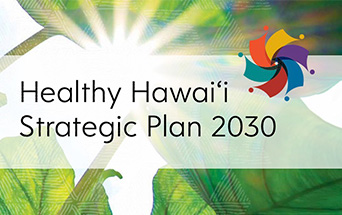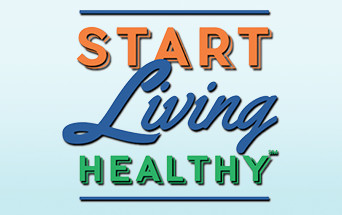State PAN Plan
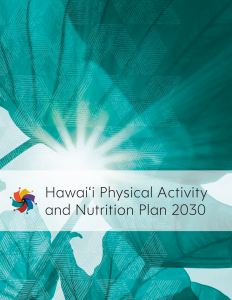 The State PAN Plan 2030 was created by and for community-based organizations, public health professionals, elected officials, and other decision-makers. It is the result of lessons learned from the implementation of the previous PAN plans: PAN Plan, 2007-2012, the PAN Plan, 2007-2012 Supplement, and PAN Plan 2020. The 19 objectives are based on effective policies and best practices; they are therefore multi-sectorial, and focus on policy, systems and environmental change. Upon achievement of these objectives, Hawai‘i’s people will have the support they need to make healthy choices where they live, work, learn, and play.
The State PAN Plan 2030 was created by and for community-based organizations, public health professionals, elected officials, and other decision-makers. It is the result of lessons learned from the implementation of the previous PAN plans: PAN Plan, 2007-2012, the PAN Plan, 2007-2012 Supplement, and PAN Plan 2020. The 19 objectives are based on effective policies and best practices; they are therefore multi-sectorial, and focus on policy, systems and environmental change. Upon achievement of these objectives, Hawai‘i’s people will have the support they need to make healthy choices where they live, work, learn, and play.
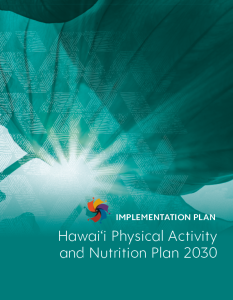 The Hawai‘i Physical Activity and Nutrition Plan 2030 Implementation Plan, or Hawai‘i Social Determinants of Health Accelerator Plan (SDOH AP), presents activities that will accelerate progress towards the completion of the PAN Plan 2030 Objectives. The SDOH AP provides a roadmap towards the implementation of the PAN Plan 2030 objectives, which will improve health, reduce the prevalence of chronic disease, and reduce health disparities among low-income residents, Native Hawaiian and Other Pacific Islander (NHOPI), and Filipinos, through prevention efforts.
The Hawai‘i Physical Activity and Nutrition Plan 2030 Implementation Plan, or Hawai‘i Social Determinants of Health Accelerator Plan (SDOH AP), presents activities that will accelerate progress towards the completion of the PAN Plan 2030 Objectives. The SDOH AP provides a roadmap towards the implementation of the PAN Plan 2030 objectives, which will improve health, reduce the prevalence of chronic disease, and reduce health disparities among low-income residents, Native Hawaiian and Other Pacific Islander (NHOPI), and Filipinos, through prevention efforts.
Virtual PAN Plan 2030 and Healthy Hawai‘i Strategic Plan 2030 Launch
CDPHPD hosted a virtual launch event for the Healthy Hawai‘i Strategic Plan 2030 (HHSP) and the following Program Area Plans – Asthma, Cancer, Diabetes, Heart Disease and Stroke, Physical Activity and Nutrition, and Tobacco – on June 14, 2021. The HHSP and Program Area Plans provide a roadmap for preventing and reducing the burden of chronic disease in our state. The HHSP is a guide to enable coordination across common risk factors, interventions, and strategies. The HHSP and PAN Plan 2030 identify priority objectives in four sector areas – Community Design and Access (Nutrition and Physical Activity), Education, Health Care, and Worksite. Working on health priorities in these sector areas will create sustainable changes where people live, learn, work, and play, so healthy options become the default. The HHSP and PAN Plan 2030 are living documents and partners – present and future – are invited to work together to achieve the “Healthy Hawai‘i Vision 2030.”
2022 PAN Summit and PAN Plan 2030 Implementation Plan
 The CDPHPD and Primary Prevention Branch (PPB) hosted a Physical Activity and Nutrition (PAN) Summit on September 29, 2022 to celebrate and launch the PAN Plan 2030 Implementation Plan.
The CDPHPD and Primary Prevention Branch (PPB) hosted a Physical Activity and Nutrition (PAN) Summit on September 29, 2022 to celebrate and launch the PAN Plan 2030 Implementation Plan.
Keynote speaker Dr. Anthony Iton gave a powerful overview on the Social Determinants of Health and shared a message on building social, political, and economic power in communities. Community partners also discussed opportunities for collaboration across the Community Design and Access, Education, Health Care, and Worksite sectors through sector breakout sessions and a panel presentation.
 The PAN Plan 2030 Implementation Plan was presented as a roadmap forward with activities that will accelerate progress and lead to the completion of the PAN Plan 2030 objectives. This plan was created with the Centers for Disease Control and Prevention (CDC) funding, “Closing the Gap with Social Determinants of Health Accelerator Plans (DP21-2111), which supported the convening of community partners to prioritize existing and anticipated resources towards completion of the PAN Plan 2030 objectives. The statewide implementation-ready, culturally informed Implementation Plans focuses on policy, systems, and environmental changes for the built environment, and food and nutrition security across the sectors of Community Design and Access, Education, Health Care, and Worksite.
The PAN Plan 2030 Implementation Plan was presented as a roadmap forward with activities that will accelerate progress and lead to the completion of the PAN Plan 2030 objectives. This plan was created with the Centers for Disease Control and Prevention (CDC) funding, “Closing the Gap with Social Determinants of Health Accelerator Plans (DP21-2111), which supported the convening of community partners to prioritize existing and anticipated resources towards completion of the PAN Plan 2030 objectives. The statewide implementation-ready, culturally informed Implementation Plans focuses on policy, systems, and environmental changes for the built environment, and food and nutrition security across the sectors of Community Design and Access, Education, Health Care, and Worksite.
2013 PAN Summit
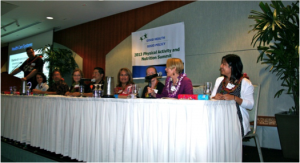 HHI hosted the 3rd Physical Activity and Nutrition (PAN) Summit on May 23rd & 24th, 2013. The conference theme “Good Health: Good Policy” focused on the importance of developing and implementing obesity prevention policies for Hawaii in the areas of nutrition and physical activity. A comprehensive policy approach to address obesity will help create the population-level changes needed to turn the tide in obesity.
HHI hosted the 3rd Physical Activity and Nutrition (PAN) Summit on May 23rd & 24th, 2013. The conference theme “Good Health: Good Policy” focused on the importance of developing and implementing obesity prevention policies for Hawaii in the areas of nutrition and physical activity. A comprehensive policy approach to address obesity will help create the population-level changes needed to turn the tide in obesity.
The PAN Summit was attended by community agencies, elected officials, advocates, planners, developers, businesses, teachers and administrators, state agencies, city and county agencies, other community groups, and the interested general public. The objectives of the summit included highlighting the need for obesity prevention policy at the state and county levels, updating participants on the latest data and trends, introducing the PAN Plan 2020, and initiating its implementation. Please see the 2013 PAN Summit Agenda (PDF) for links to all speaker presentations.


